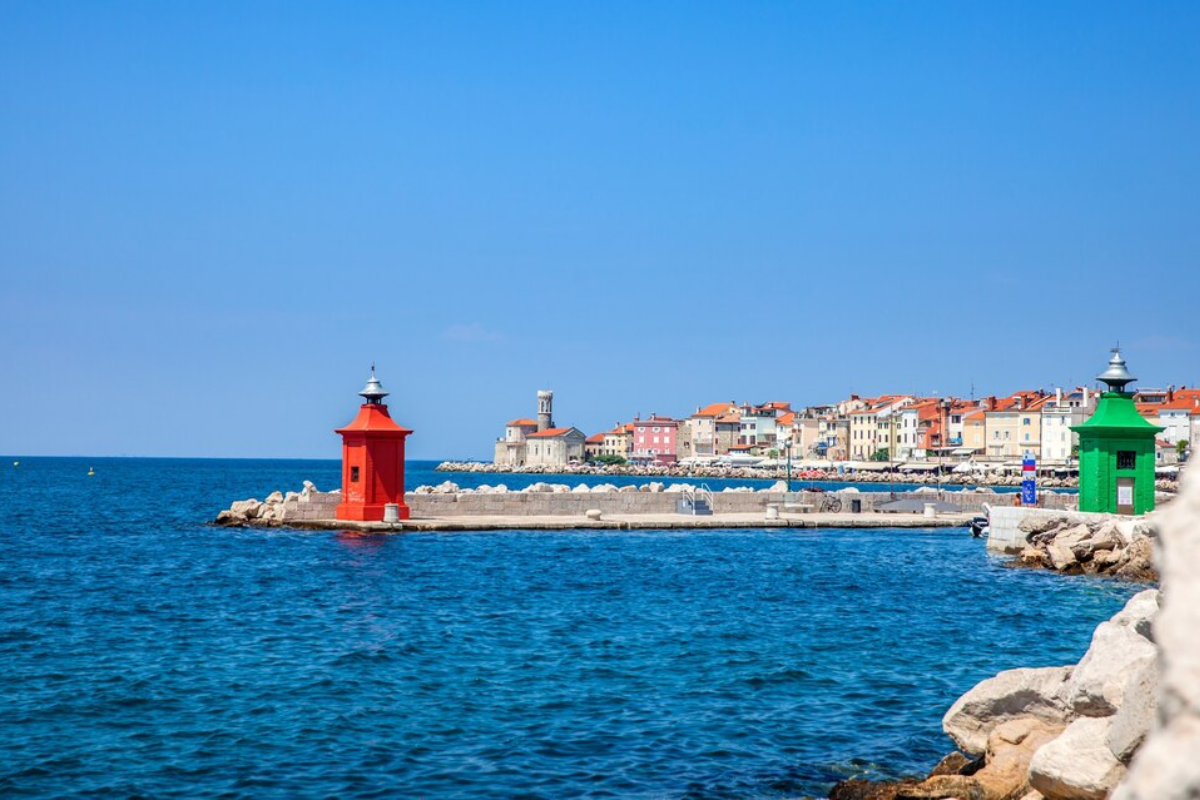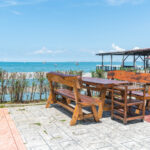Cascais, Portugal, is the kind of place that leaves a lasting impression long after you’ve strolled its sunlit promenades or dipped your toes into the Atlantic. Once the summer retreat of Portuguese royalty, this coastal gem has evolved into a vibrant blend of history, culture, and seaside charm. Elegant mansions overlook golden beaches, fishing boats bob in the marina, and the scent of fresh seafood drifts from lively waterfront cafés.
Today, Cascais is more than just a pretty stop on the map—it’s a destination where regal heritage meets modern vitality, where centuries-old fortresses share the stage with art galleries, surf spots, and gourmet dining. Whether you’re here for a weekend escape from Lisbon or a longer stay to truly immerse yourself, this guide will take you beyond the postcards. From hidden alleys and ocean viewpoints to insider dining tips and nearby natural wonders, you’ll find everything you need to make the most of your visit.
History & Cultural Heritage
A Royal Seaside Retreat
Cascais’ transformation from a quiet fishing village into a prestigious seaside retreat began in the late 19th century, when King Luís I chose it as his summer residence. Drawn by its mild climate, sweeping coastal views, and proximity to Lisbon, the king’s seasonal stays brought the nobility, diplomats, and artists in his wake. Elegant villas and ornate mansions soon lined the shore, their architectural styles reflecting the wealth and taste of Europe’s elite. Even today, walking through the old town reveals traces of this golden era—wrought-iron balconies, tiled façades, and manicured gardens that hint at its aristocratic past.
Fortresses & Palaces
At the heart of Cascais’ waterfront stands the Citadel of Cascais, a formidable fortress that has guarded the coast for centuries. Originally built to protect the harbor from invaders, it later became a royal retreat and now houses a blend of modern uses: an arts district, luxury hotel, and event space. Adjacent to it lies the Cascais Citadel Palace Museum, where visitors can explore restored royal chambers and learn about the site’s dual role as a defensive stronghold and a royal residence. The combination of military history and regal elegance makes it a unique cultural landmark.
Lighthouses & Museums
Cascais’ maritime heritage comes to life at the Santa Marta Lighthouse and Museum, a striking white-and-blue tower that has guided sailors since the 19th century. Inside, exhibits trace the evolution of lighthouse technology and the region’s deep connection to the sea.
The town is also home to a collection of notable cultural institutions. The Cascais Cultural Centre hosts rotating art exhibitions in a serene setting, while the Casa de Santa Maria—a former luxury home—showcases decorative arts and architectural beauty. For a step further into history, the Conde de Castro Guimarães Museum blends Gothic Revival style with rare art collections, ancient manuscripts, and even a medieval cloister, offering a glimpse into the tastes of one of Cascais’ most influential families.
Natural Beauty & Outdoor Attractions
Beaches & Coastal Landscapes
Cascais is blessed with some of Portugal’s most picturesque beaches, each with its own personality. Praia da Poça and Praia da Rainha offer sheltered sands and calm waters, perfect for leisurely swims or simply soaking up the sun with an espresso in hand. Just a short drive away, Praia do Guincho is a different world—wide, windswept, and framed by rugged cliffs. Known for its powerful surf and unspoiled scenery, it draws surfers, kiteboarders, and photographers chasing dramatic Atlantic sunsets.
The coast here invites exploration beyond the beaches. One of the most famous stops is Boca do Inferno (“Hell’s Mouth”), a dramatic cliff formation where waves crash into a natural arch, sending up plumes of spray. From there, a scenic coastal path stretches toward Estoril, offering sweeping views, salty breezes, and plenty of spots to pause for photos.
Sintra-Cascais Natural Park
Just beyond the town lies the Sintra-Cascais Natural Park, a protected area where lush forests, craggy cliffs, and rolling hills converge. Highlights include Cabo da Roca, the westernmost point of mainland Europe, where the land meets the ocean in a breathtaking panorama. Deeper inland, the park reveals treasures like the Castle of the Moors, Pena Palace, and Monserrate Palace—each a testament to Portugal’s layered history and artistic heritage.
Whether you hike the park’s trails, explore hidden coves, or simply drive through its winding roads, the variety of landscapes makes it a must for nature lovers.
Unique Experiences
Cascais offers outdoor adventures that go beyond the typical beach day. Eco-conscious travelers can join solar-powered boat tours to quietly glide along the coast, spotting marine life and hidden coves without leaving a carbon footprint.
For something truly memorable, join a foraging hike led by local expert Fernanda Botelho, who shares her knowledge of wild herbs, edible plants, and the traditions behind them. The experience often ends with a nature-to-table meal, turning the day’s finds into a delicious, locally inspired feast—a rare blend of outdoor exploration and culinary artistry.
Gastronomy & Culinary Culture
From Markets to Michelin
Food is at the heart of life in Cascais, and nowhere is this more evident than at its bustling seafood markets. Marisco na Praça is a local favorite—part market, part informal restaurant—where you can choose your seafood from the counter and have it grilled on the spot. The atmosphere is lively, the produce fresh, and the flavors distinctly Atlantic.
For a fine dining experience, Cascais holds its own on the culinary map. Maré by José Avillez offers refined interpretations of Portuguese coastal cuisine, with dishes that are as visually stunning as they are flavorful. Meanwhile, Lota da Esquina, led by celebrated chef Vítor Sobral, brings a creative twist to traditional recipes, often showcasing the best seasonal seafood and produce from the region.
Local Flavors & Workshops
Beyond restaurants, Cascais is a place to truly taste tradition. Local menus often feature amêijoas à Bulhão Pato, a simple yet irresistible dish of clams in garlic, olive oil, and cilantro, best enjoyed with crusty bread to soak up the sauce. In pastelarias (bakeries), you’ll find delicate pastries like travesseiros or, of course, the iconic pastel de nata.
For those who like to get hands-on, the Cascais Food Lab offers cooking classes where you can learn the techniques behind classic Portuguese dishes, guided by local chefs. It’s an immersive way to bring a piece of Cascais’ culinary heritage home with you.
Wine lovers will find the nearby Colares wine region particularly rewarding. Known for its rare Ramisco grapes grown in sandy coastal soils, the area offers intimate tasting tours where you can pair distinctive wines with artisanal cheeses and freshly baked bread. This combination of local craftsmanship and natural terroir makes for a deeply authentic gastronomic experience.
Lifestyle & Expat Perspective
Living the Cascais Life
For many who visit, Cascais isn’t just a holiday stop—it’s a place they can imagine calling home. Its combination of coastal beauty, rich cultural life, and modern conveniences makes it especially appealing to expats. The climate is mild year-round, the streets feel safe, and there’s a welcoming international community that blends seamlessly with the town’s local traditions.
Life here moves at a balanced pace. Mornings might begin with a café and pastel at a seaside bakery, followed by a swim or a walk along the promenade. Afternoons can be spent exploring art galleries, browsing local shops, or taking the train into Lisbon for a dose of city life. Evenings often revolve around good food, whether at a casual taverna or a fine dining spot with an ocean view.
Civic Innovation
Cascais is also recognized within Portugal for its forward-thinking approach to governance, particularly through its participatory budgeting program. This model allows residents to directly propose and vote on projects that shape the town—from public gardens and community centers to cultural events and environmental initiatives.
For locals and expats alike, this isn’t just a policy—it’s a way to feel actively involved in the community’s development. It reflects Cascais’ ability to preserve its historic character while embracing modern, inclusive ways of shaping its future.
Practical Travel Planning
Getting There & When to Go
Cascais is one of the easiest coastal towns to reach from Lisbon, making it a favorite for both spontaneous day trips and extended stays. From the Cais do Sodré station in Lisbon, a direct train hugs the coastline for just under an hour, offering glimpses of sandy beaches and fishing villages along the way.
While Cascais is welcoming year-round, the best times to visit are spring, early summer, and autumn. These seasons offer warm, sunny days without the peak-season crowds of July and August. You’ll have an easier time booking accommodations, and the town’s streets, beaches, and restaurants feel more relaxed.
Suggested Visit Durations
A day trip from Lisbon is enough to explore the marina, visit a museum or two, and enjoy a leisurely seafood lunch. But to truly appreciate Cascais’ layered appeal—its beaches, historic sites, natural parks, and culinary experiences—consider staying at least two to three nights. This gives you time to explore the Sintra-Cascais Natural Park, enjoy a sunset at Boca do Inferno, and wander the old town without rushing.
Accommodation Tips
For a memorable stay, look for boutique hotels or guesthouses in historic buildings, many of which feature ocean views and stylish interiors that blend tradition with modern comfort. Staying near the old town means you can walk to most attractions, while properties slightly farther out often offer quieter surroundings and direct beach access.
Insider Tips
Locals will tell you that Cascais rewards those who slow down and look closer. Start your morning with a pastel de nata at Pastelaria Garrett or another beloved neighborhood bakery. Seek out hidden viewpoints like the one near Santa Marta Lighthouse, where you can watch the waves without a crowd. If you’re walking the coastal path, go early in the morning or just before sunset for the softest light and the fewest people.
And sometimes, the best moments are the simplest—sitting on the marina’s edge at sunset, watching the fishing boats return as the sky turns gold and the town’s lights begin to shimmer.
Conclusion
Cascais, Portugal is more than a beautiful seaside town—it’s a destination where history, nature, and modern life intertwine in a way that feels effortlessly authentic. Here, centuries-old fortresses stand beside contemporary art spaces, royal palaces overlook lively marinas, and golden beaches give way to untamed coastal cliffs. It’s a place where you can spend the morning exploring a museum, the afternoon surfing at Guincho, and the evening savoring fresh seafood with the Atlantic breeze at your back.
The real magic of Cascais comes when you go beyond the obvious. Wander into quiet side streets lined with tiled façades, pause at hidden viewpoints known mostly to locals, or join a foraging hike that ends in a shared table of coastal flavors. Whether you’re here for a day, a week, or to make it your new home, Cascais rewards curiosity and invites you to slow down, look closer, and experience its many layers for yourself.
My name is Micheal Lovell. I am a dedicated travel writer with over 7 years of experience in creating informative and engaging travel content. Throughout my journey, I have published travel blogs that help readers explore new destinations, plan better trips, and discover local cultures and hidden gems around the world. My goal is to provide practical travel insights through well-researched articles that inspire and guide travelers at every step of their journey.










